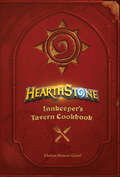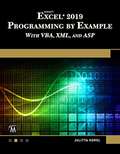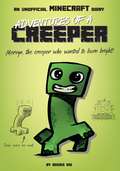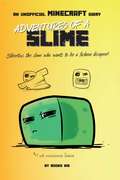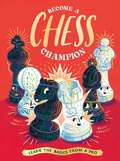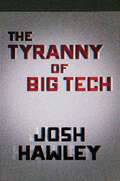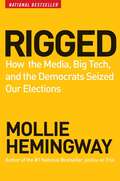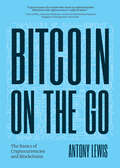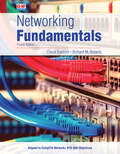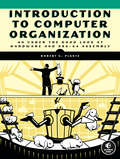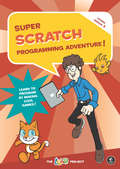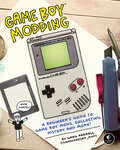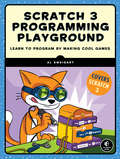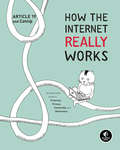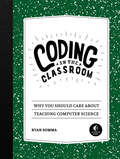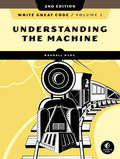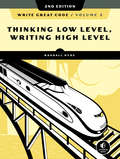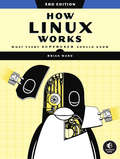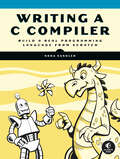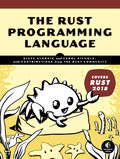- Table View
- List View
Hearthstone: Innkeeper's Tavern Cookbook
by Chelsea Monroe-CasselSheathe your sword and summon more than fifty delicious bites and cocktails inspired by the smash-hit game—perfect for any Fireside Gathering.From the bestselling author of World of Warcraft: The Official Cookbook and A Feast of Ice and Fire: The Official Game of Thrones Companion Cookbook comes a new collection of delicious recipes.With the Innkeeper’s Tavern Cookbook, fans will unlock Hearthstone-inspired eats, cocktails, and mocktails. A replica of Harth Stonebrew’s own private cookbook, this delightful guide contains more than fifty all-new recipes perfect for any Fireside Gathering or game night, from Sarge’s Easy Mac & Cheese to Medivh’s favorite martini—and, of course, funnel cake. Complete with mouthwatering color photos and Harth’s personal notations, recipe modifications, and reflections, the Innkeeper’s Tavern Cookbook brings the world of Hearthstone to life like never before. Hearthstone is a fast-paced digital card game where players sling spells, summon minions, and command powerful heroes in duels of epic strategy. Featuring familiar characters from the Warcraft® universe, Hearthstone has won over legions of fans with its humor and deceptively simple gameplay.
Microsoft Excel 2019 Programming by Example: With VBA, XML, and ASP
by Julitta KorolUpdated for Excel 2019 and based on the bestselling editions from previous versions, Microsoft Excel 2019 Programming by Example with VBA, XML and ASP is a practical, how-to book on Excel programming, suitable for readers already proficient with the Excel user interface (UI). The book includes companion files with all of the source code and figures used in the text (available with Amazon proof of purchase by writing to the publisher at info@merclearning.com.) <p><p> If you are looking to automate Excel routine tasks, this book will progressively introduce you to programming concepts via numerous illustrated hands-on exercises. More advanced topics are demonstrated via custom projects. From recording and editing a macro and writing VBA code to working with XML documents and using Classic ASP pages to access and display data on the Web, this book takes you on a programming journey that will change the way you work with Excel. The book provides information on performing automatic operations on files, folders, and other Microsoft Office applications. It also covers proper use of event procedures, testing and debugging, and guides you through programming advanced Excel features such as PivotTables, PivotCharts, and the Ribbon interface.
Adventures of a Creeper: An Unofficial Minecraft Diary (Minecraft #1)
by Books KidIn this humorous, illustrated chapter-book diary, you’ll find out that life is not always a blast—even if you’re an exploding Minecraft creeper!Minecraft creeper Mervyn Miles has just one goal: to win the annual Creeper Combustion and Confusion Competition so his father will finally be proud of him. But, between family and school pressures and bullying by arch-rival Wesley, things turn out to be more difficult than Mervyn could have ever imagined. Read all about this little green monster’s quest to become the biggest exploder in the entire Overworld in this humorous, unofficial Minecraft chapter-book diary with black-and-white illustrations.
Adventures of a Slime: An Unofficial Minecraft Diary (Minecraft #2)
by Books KidA Simon & Schuster eBook. Simon & Schuster has a great book for every reader.
Screen Time: Photography and Video Art in the Internet Age
by Richard Rinehart and Phillip ProdgerPublished on the occasion of the art exhibition Screen Time: Photography and Video Art in the Internet Age, this catalog features a selection of leading international artists who engage with and critique the role of media in contemporary society. Their work demonstrates what has become known as post-internet artistic practices—art that may or may not be made for the internet but nevertheless acknowledges online culture as an omnipresent influence, inseparable from contemporary social conditions. They ask what it means to be a photographer when everyone is an Instagram influencer; what it means to make video art when everyone is a TikTok video star; and how to deliver meaningful social commentary in the age of the meme. The exhibition and accompanying catalog showcase artwork by N. Dash, Nathalie Djurberg, Marcel Dzama, Peter Funch, Cyrus Kabiru, William Kentridge, Christian Marclay, Marilyn Minter, Vik Muniz, Otobong Nkanga, Erwin Olaf, Robin Rhode, Vee Speers, Mary Sue, Puck Verkade, Huang Yan. Published by Bucknell University Press for the Samek Art Museum. Distributed worldwide by Rutgers University Press.
Become a Chess Champion: Learn the Basics from a Pro
by Neon Squid James Canty IIIKids will learn how to master the basics of the classic board game in this fun beginner’s guide from professional chess player James Canty III.Become a Chess Champion is structured like a chess course, with knowledge carefully introduced as readers turn the pages – assisted by hilarious chess pieces illustrated by Brian Lambert. The emphasis is on fun: James Canty III uses mini games and chess puzzles to teach important concepts and avoid overwhelming beginners. Kids will learn key skills like how to play the perfect opening and trick their opponents to bring about checkmate. By the end of the book readers should be able to confidently take on their parents, guardians or grandparents in a competitive game of chess!Become a Chess Champion also introduces kids to the wonderful world of chess. They’ll meet the chess player who didn’t lose a game for 30 years, the priest who invented the folding chess board, and the astronauts on the International Space station who had a chess match with people back on Earth!As well as being great fun, chess also helps kids develop key skills such as strategising, patience, and logic, and helps them excel in school subjects such as mathematics.The cover features gold foil, making this book the perfect gift. Check it out!
The Tyranny of Big Tech
by Josh HawleyThe reign of Big Tech is here, and Americans’ First Amendment rights hang by a keystroke. Amassing unimaginable amounts of personal data, giants like Google, Facebook, Amazon, and Apple—once symbols of American ingenuity and freedom—have become a techno-oligarchy with overwhelming economic and political power. Decades of unchecked data collection have given Big Tech more targeted control over Americans’ daily lives than any company or government in the world. <P><P> In The Tyranny of Big Tech, Senator Josh Hawley of Missouri argues that these mega-corporations—controlled by the robber barons of the modern era—are the gravest threat to American liberty in decades. To reverse course, Hawley argues, we must correct progressives’ mistakes of the past. <P><P>That means recovering the link between liberty and democratic participation, building an economy that makes the working class strong, independent, and beholden to no one, and curbing the influence of corporate and political elites. <P><P>Big Tech and its allies do not deal gently with those who cross them, and Senator Hawley proudly bears his own battle scars. But hubris is dangerous. The time is ripe to overcome the tyranny of Big Tech by reshaping the business and legal landscape of the digital world. <P><P><b>A New York Times Bestseller</b>
Rigged: How the Media, Big Tech, and the Democrats Seized Our Elections
by Mollie HemingwayFROM THE AUTHOR OF THE #1 NATIONAL BESTSELLER JUSTICE ON TRIAL Stunned by the turbulence of the 2020 election, millions of Americans are asking the forbidden question: what really happened? It was a devastating triple punch. Capping their four-year campaign to destroy the Trump presidency, the media portrayed a Democratic victory as necessary and inevitable. Big Tech, wielding unprecedented powers, vaporized dissent and erased damning reports about the Biden family's corruption. And Democratic operatives, exploiting a public health crisis, shamelessly manipulated the voting process itself. Silenced and subjected, the American people lost their faith in the system. RIGGED is the definitive account of the 2020 election. Based on Mollie Hemingway's exclusive interviews with campaign officials, reporters, Supreme Court justices, and President Trump himself, it exposes the fraud and cynicism behind the Democrats' historic power-grab. Rewriting history is a specialty of the radical left, now in control of America's political and cultural heights. But they will have to contend with the determination, insight, and eloquence of Mollie Hemingway. RIGGED is a reminder for weary patriots that truth is still the most powerful weapon. The stakes for our democracy have never been higher.
Skyrocket Your Business with Social Media Branding: Personalize, Increase, and Grow Demand for your Brand
by Isis BradfordSkyrocket Your Business with Social Media Branding"As a next-generation leader and trusted voice in the digital arena, Isis Bradford provides the blueprint to take your brand from the ground floor all the way to the top.” —Pauleanna Reid, founder of WritersBlok and nationally published journalistSkyrocket Your Business with Social Media Branding guides you on how to start and build your brand and business. Through social media branding and selling digital products, you can scale your business to be extremely lucrative—let’s get started!Grow your business and your brand. Social media strategist and content expert Isis Bradford created this guide book to help small business owners acclimate to social media branding and promoting digital products and goods. Learn how to utilize an instagram following to your advantage without a business development manager using Bradford’s The P.A.I.D. Equation method. P.A.I.D stands for how to (P)personalize the experience of your audience, bring (A)awareness to your business daily, create an (I)intimate relationship with those who are ready to shop from you, and increase (D)demand for purchases!Social media and business strategies made simple. Engage with your audience using updated strategies on social media branding. Learn how to personalize intended experiences for your audience, build brand awareness daily on social media, and inspire your audience to purchase any of your digital products and courses without famous influencers. Inside, you’ll find:Marketing and social media branding guidelines to grow your businessBusiness strategies to inspire purchases of your digital products and coursesAn online business book taking digital serial entrepreneurs to the next levelIf you liked Hook Point, The Nuclear Effect, or The Fearless Woman's Guide to Starting a Business, you’ll love Skyrocket Your Business with Social Media Branding.
Bitcoin on the Go: The Basics of Bitcoins and Blockchains
by Antony LewisA Condensed Guide to Understanding Bitcoin, Blockchains, and Cryptocurrency“One of the few credible books I suggest when people ask ‘where can I learn about bitcoin?’―Zennon Kapron, Managing Director, Kapronasia (Review of The Basics of Bitcoins and Blockchains)You’re an active, on-the-go person and need a condensed version of the Antony Lewis best-selling The Basics of Bitcoins and Blockchains? Now Bitcoin on the Go offers the same clear guide to this new currency and the revolutionary technology that powers it―just in a condensed format.Bitcoin, Ethereum, and other cryptocurrencies. Gain an understanding of a broad spectrum of Bitcoin topics including the history of Bitcoin, the Bitcoin blockchain, and Bitcoin buying, selling, and mining. Learn how payments are made, and how to put a value on cryptocurrencies and digital tokens.Blockchain technology. What exactly is a blockchain, how does it work, and why is it important? Bitcoin on the Go answers these questions and more. Learn about notable blockchain platforms, smart contracts, and other important facets of blockchains and their function in the changing cyber-economy.Things to know before buying cryptocurrencies. Find trustworthy and balanced insights into Bitcoin investing and investing in other cryptocurrencies. Discover the risks and mitigations, learn how to identify scams, and understand cryptocurrency exchanges, digital wallets, and regulations.Learn about:Blockchain technology and how it worksWorkings of the cryptocurrency marketEvolution and potential impacts of Bitcoin and blockchains on global businessesYou’ve read The Bitcoin Standard, Blockchain Bubble or Revolution, the full version of The Basics of Bitcoins and Blockchains by Antony Lewis, or The Only Cryptocurrency Investing Book You'll Ever Need but you want to understand this new currency in a quick easy-to-read format. Pick up a copy of Bitcoin on the Go.
Ewen and Cat's Wee Book of Aye or Naw
by Cat HarveyWill Ewen and Cat's Wee Book of Aye or Naw change your life? NAW. But will it make you instantly more interesting to other humans? OH AYE!Not your typical quiz book.Ewen and Cat's Wee Book of Aye or Naw is a rollicking adventure through 500 quiz questions that promise to test your knowledge on EVERYTHING! This book of brain teasers for adults is an exploration into the hilarious behind-the-scenes moments and puzzling brain busters that characterize the UK award-winning radio show Ewen and Cat at Breakfast.Perfect blend of fun facts and trivia. Packed with true or false questions like "Usain Bolt would beat a cat over 100m," and "A jiffy is a real unit of time," or "Volkswagen sells more sausages than cars," readers are in for a treat. This book transcends the traditional quiz questions book by emphasizing the joy of finding new facts and connection to other people through shared knowledge. It's not just about testing your memory; it's about the pleasure of discovering fascinating facts and engaging in lively conversations with others.Inside:Be bemused and amused as you dive into a journey of daily funTackle exciting true or false questions on your quest for new knowledgeFind compelling reasons to share this quiz questions book with friends and familyIf you are seeking a book of quiz questions such as Awesome Facts That Will Make You Look Super Smart, Trivia for Seniors, or So You Think You Know Baseball then Ewen and Cat's Wee Book of Aye or Naw is for you!
Networking Fundamentals
by Richard M. Roberts Chuck EasttomNetworking Fundamentals provides a foundation for individuals wishing to pursue a career in information technology with a specific focus on networking and network administration. The introductory text guides students through the basics of networking, such as topographies, media, subnetting, servers, and design. Networking Fundamentals is aligned to the CompTIA Network+ N10-008 Certification Exam objectives. The CompTIA Network+ Exam is a CompTIA Core Skills Certification, which provides a groundwork for future career growth. By studying Networking Fundamentals and using the ancillary study guide and lab manual, students can improve their chances of earning an industry-recognized certification that will help jumpstart their careers.
Work From Home: 50 Ways to Make Money Online Analyzed
by Michael EzeanakaMichael Ezeanaka, provides a step-by-step analysis of 50 business models that have the potential to earn you passive income. A quick overview of each business is presented and their simplicity, passivity, scalability and level of competition in the marketplace are explored.
Foundations of Information Security: A Straightforward Introduction
by Jason AndressHigh-level overview of the information security field. Covers key concepts like confidentiality, integrity, and availability, then dives into practical applications of these ideas in the areas of operational, physical, network, application, and operating system security.In this high-level survey of the information security field, best-selling author Jason Andress covers the basics of a wide variety of topics, from authentication and authorization to maintaining confidentiality and performing penetration testing.Using real-world security breaches as examples, Foundations of Information Security explores common applications of these concepts, such as operations security, network design, hardening and patching operating systems, securing mobile devices, as well as tools for assessing the security of hosts and applications. You'll also learn the basics of topics like:Multifactor authentication and how biometrics and hardware tokens can be used to harden the authentication processThe principles behind modern cryptography, including symmetric and asymmetric algorithms, hashes, and certificatesThe laws and regulations that protect systems and dataAnti-malware tools, firewalls, and intrusion detection systemsVulnerabilities such as buffer overflows and race conditionsA valuable resource for beginning security professionals, network systems administrators, or anyone new to the field, Foundations of Information Security is a great place to start your journey into the dynamic and rewarding field of information security.
Introduction to Computer Organization: An Under the Hood Look at Hardware and x86-64 Assembly
by Robert PlantzThis hands-on tutorial is a broad examination of how a modern computer works. Classroom tested for over a decade, it gives readers a firm understanding of how computers do what they do, covering essentials like data storage, logic gates and transistors, data types, the CPU, assembly, and machine code.Introduction to Computer Organization gives programmers a practical understanding of what happens in a computer when you execute your code. You may never have to write x86-64 assembly language or design hardware yourself, but knowing how the hardware and software works will give you greater control and confidence over your coding decisions. We start with high level fundamental concepts like memory organization, binary logic, and data types and then explore how they are implemented at the assembly language level.The goal isn&’t to make you an assembly programmer, but to help you comprehend what happens behind the scenes between running your program and seeing &“Hello World&” displayed on the screen. Classroom-tested for over a decade, this book will demystify topics like: • How to translate a high-level language code into assembly language • How the operating system manages hardware resources with exceptions and interrupts • How data is encoded in memory • How hardware switches handle decimal data • How program code gets transformed into machine code the computer understands • How pieces of hardware like the CPU, input/output, and memory interact to make the entire system workAuthor Robert Plantz takes a practical approach to the material, providing examples and exercises on every page, without sacrificing technical details. Learning how to think like a computer will help you write better programs, in any language, even if you never look at another line of assembly code again.
Super Scratch Programming Adventure! (Scratch 3)
by The LEAD ProjectComics! Games! Programming! Now updated to cover Scratch 3.Scratch is the wildly popular educational programming language used by millions of first-time learners in classrooms and homes worldwide. By dragging together colorful blocks of code, kids can learn computer programming concepts and make cool games and animations. The latest version, Scratch 3, features an updated interface, new sprites and programming blocks, and extensions that let you program things like the micro:bit.In Super Scratch Programming Adventure!, kids learn programming fundamentals as they make their very own playable video games. They'll create projects inspired by classic arcade games that can be programmed (and played!) in an afternoon. Patient, step-by-step explanations of the code and fun programming challenges will have kids creating their own games in no time.This full-color comic book makes programming concepts like variables, flow control, and subroutines effortless to absorb. Packed with ideas for games that kids will be proud to show off, Super Scratch Programming Adventure! is the perfect first step for the budding programmer.Covers Scratch 3
Game Boy Modding: A Beginner's Guide to Game Boy Mods, Collecting, History, and More!
by Greg FarrellComplete beginner's guide to all aspects of modifying the classic Nintendo Game Boy.Game Boy Modding teaches you how to purchase, refurbish, mod, and customize Nintendo handheld consoles. The consoles are widely available and the customizations are affordable, requiring only limited tools and know-how. Retro consoles are seeing a resurgence of popularity worldwide, and king among these throwback devices is the Nintendo Game Boy, which sold over 100 million units in its lifetime and introduced gamers to Mario and Pokemon. These consoles emanate pixelated 8-bit retro charm, but lack the modern technological enhancements that we take for granted in 2020. You'll learn basic soldering and hardware modification techniques; how to change speakers, buttons, and screen lenses; how to fix dead speakers and sticky buttons; and how to personalize your Game Boy to your heart's content.
Scratch 3 Programming Playground: Learn to Program by Making Cool Games
by Al SweigartA project-filled introduction to coding that shows kids how to build programs by making cool games. Scratch, the colorful drag-and-drop programming language, is used by millions of first-time learners worldwide. Scratch 3 features an updated interface, new programming blocks, and the ability to run on tablets and smartphones, so you can learn how to code on the go.In Scratch 3 Programming Playground, you'll learn to code by making cool games. Get ready to destroy asteroids, shoot hoops, and slice and dice fruit! Each game includes easy-to-follow instructions with full-color images, review questions, and creative coding challenges to make the game your own. Want to add more levels or a cheat code? No problem, just write some code.You'll learn to make games like: • Maze Runner: escape the maze! • Snaaaaaake: gobble apples and avoid your own tail • Asteroid Breaker: smash space rocks • Fruit Slicer: a Fruit Ninja clone • Brick Breaker: a remake of Breakout, the brick-breaking classic • Platformer: a game inspired by Super Mario BrosLearning how to program shouldn't be dry and dreary. With Scratch 3 Programming Playground, you'll make a game of it!Covers: Scratch 3
How the Internet Really Works: An Illustrated Guide to Protocols, Privacy, Censorship, and Governance
by Article 19An accessible, comic book-like, illustrated introduction to how the internet works under the hood, designed to give people a basic understanding of the technical aspects of the Internet that they need in order to advocate for digital rights.The internet has profoundly changed interpersonal communication, but most of us don't really understand how it works. What enables information to travel across the internet? Can we really be anonymous and private online? Who controls the internet, and why is that important? And... what's with all the cats?How the Internet Really Works answers these questions and more. Using clear language and whimsical illustrations, the authors translate highly technical topics into accessible, engaging prose that demystifies the world's most intricately linked computer network. Alongside a feline guide named Catnip, you'll learn about: • The "How-What-Why" of nodes, packets, and internet protocols • Cryptographic techniques to ensure the secrecy and integrity of your data • Censorship, ways to monitor it, and means for circumventing it • Cybernetics, algorithms, and how computers make decisions • Centralization of internet power, its impact on democracy, and how it hurts human rights • Internet governance, and ways to get involvedThis book is also a call to action, laying out a roadmap for using your newfound knowledge to influence the evolution of digitally inclusive, rights-respecting internet laws and policies.Whether you're a citizen concerned about staying safe online, a civil servant seeking to address censorship, an advocate addressing worldwide freedom of expression issues, or simply someone with a cat-like curiosity about network infrastructure, you will be delighted -- and enlightened -- by Catnip's felicitously fun guide to understanding how the internet really works!
Coding in the Classroom: Why You Should Care About Teaching Computer Science
by Ryan SommaA book for anyone teaching computer science, from elementary school teachers and coding club coaches to parents looking for some guidance.Computer science opens more doors for today's youth than any other discipline - which is why Coding in the Classroom is your key to unlocking students' future potential. Author Ryan Somma untangles the current state of CS education standards; describes the cognitive, academic, and professional benefits of learning CS; and provides numerous strategies to promote computational thinking and get kids coding! Whether you're a teacher, an after-school coach, or a parent seeking accessible ways to boost your kid's computer savvy, Coding in the Classroom is here to help. With quick-start programming strategies, scaffolded exercises for every grade level, and ideas for designing CS events that promote student achievement, this book is a rock-solid roadmap to CS integration from a wide variety of on-ramps. You'll learn: • tips and resources for teaching programming concepts via in-class activities and games, without a computer • development environments that make coding and sharing web apps a breeze • lesson plans for the software lifecycle process and techniques for facilitating long-term projects • ways to craft interdisciplinary units that bridge CS and computational thinking with other content areas Coding in the Classroom does more than make CS less formidable - it makes it more fun! From learning computational thinking via board games to building their own websites, students are offered a variety of entry points for acquiring the skills they need to succeed in the 21st-century workforce. Moreover, Somma understands how schools operate - and he's got your back. You'll be empowered to advocate for the value of implementing CS across the curriculum, get stakeholder buy-in, and build the supportive, equitable coding community that your school deserves.
Write Great Code, Volume 1, 2nd Edition: Understanding the Machine
by Randall HydeUnderstanding the Machine, the first volume in the landmark Write Great Code series by Randall Hyde, explains the underlying mechanics of how a computer works.This, the first volume in Randall Hyde's Write Great Code series, dives into machine organization without the extra overhead of learning assembly language programming. Written for high-level language programmers, Understanding the Machine fills in the low-level details of machine organization that are often left out of computer science and engineering courses. Learn:How the machine represents numbers, strings, and high-level data structures, so you'll know the inherent cost of using them.How to organize your data, so the machine can access it efficiently.How the CPU operates, so you can write code that works the way the machine does.How I/O devices operate, so you can maximize your application's performance when accessing those devices.How to best use the memory hierarchy to produce the fastest possible programs.Great code is efficient code. But before you can write truly efficient code, you must understand how computer systems execute programs and how abstractions in programming languages map to the machine's low-level hardware. After all, compilers don't write the best machine code; programmers do. This book gives you the foundation upon which all great software is built.NEW IN THIS EDITION, COVERAGE OF:Programming languages like Swift and JavaCode generation on modern 64-bit CPUsARM processors on mobile phones and tabletsNewer peripheral devicesLarger memory systems and large-scale SSDs
Write Great Code, Volume 2, 2nd Edition: Thinking Low-Level, Writing High-Level
by Randall HydeExplains how compilers translate high-level language source code (like code written in Python) into low-level machine code (code that the computer can understand) to help readers understand how to produce the best low-level, computer readable machine code.In the beginning, most software was written in assembly, the CPU's low-level language, in order to achieve acceptable performance on relatively slow hardware. Early programmers were sparing in their use of high-level language code, knowing that a high-level language compiler would generate crummy, low-level machine code for their software. Today, however, many programmers write in high-level languages like Python, C/C++/C#, Java, Swift. The result is often sloppy, inefficient code. But you don't need to give up the productivity and portability of high-level languages in order to produce more efficient software.In this second volume of the Write Great Code series, you'll learn: • How to analyze the output of a compiler to verify that your code does, indeed, generate good machine code • The types of machine code statements that compilers typically generate for common control structures, so you can choose the best statements when writing HLL code • Just enough 80x86 and PowerPC assembly language to read compiler output • How compilers convert various constant and variable objects into machine data, and how to use these objects to write faster and shorter programsNEW TO THIS EDITION, COVERAGE OF: • Programming languages like Swift and Java • Code generation on modern 64-bit CPUs • ARM processors on mobile phones and tablets • Stack-based architectures like the Java Virtual Machine • Modern language systems like the Microsoft Common Language RuntimeWith an understanding of how compilers work, you'll be able to write source code that they can translate into elegant machine code. That understanding starts right here, with Write Great Code, Volume 2: Thinking Low-Level, Writing High-Level.
How Linux Works, 3rd Edition: What Every Superuser Should Know
by Brian WardBest-selling guide to the inner workings of the Linux operating system with over 50,000 copies sold since its original release in 2014. Unlike some operating systems, Linux doesn&’t try to hide the important bits from you—it gives you full control of your computer. But to truly master Linux, you need to understand its internals, like how the system boots, how networking works, and what the kernel actually does. In this third edition of the bestselling How Linux Works, author Brian Ward peels back the layers of this well-loved operating system to make Linux internals accessible. This edition has been thoroughly updated and expanded with added coverage of Logical Volume Manager (LVM), virtualization, and containers. You'll learn: • How Linux boots, from boot loaders to init (systemd) • How the kernel manages devices, device drivers, and processes • How networking, interfaces, firewalls, and servers work • How development tools work and relate to shared libraries • How to write effective shell scripts You&’ll also explore the kernel and examine key system tasks inside user space, including system calls, input and output, and filesystems. With its combination of background, theory, real-world examples, and patient explanations, How Linux Works, 3rd edition will teach you what you need to know to solve pesky problems and take control of your operating system.
Writing a C Compiler: Build a Real Programming Language from Scratch
by Nora SandlerA fun, hands-on guide to writing your own compiler for a real-world programming language.Compilers are at the heart of everything programmers do, yet even experienced developers find them intimidating. For those eager to truly grasp how compilers work, Writing a C Compiler dispels the mystery. This book guides you through a fun and engaging project where you&’ll learn what it takes to compile a real-world programming language to actual assembly code.Writing a C Compiler will take you step by step through the process of building your own compiler for a significant subset of C—no prior experience with compiler construction or assembly code needed. Once you&’ve built a working compiler for the simplest C program, you&’ll add new features chapter by chapter. The algorithms in the book are all in pseudocode, so you can implement your compiler in whatever language you like. Along the way, you&’ll explore key concepts like:Lexing and parsing: Learn how to write a lexer and recursive descent parser that transform C code into an abstract syntax tree.Program analysis: Discover how to analyze a program to understand its behavior and detect errors.Code generation: Learn how to translate C language constructs like arithmetic operations, function calls, and control-flow statements into x64 assembly code.Optimization techniques: Improve performance with methods like constant folding, dead store elimination, and register allocation. Compilers aren&’t terrifying beasts—and with help from this hands-on, accessible guide, you might even turn them into your friends for life.
The Rust Programming Language (Covers Rust 2018)
by Steve Klabnik Carol NicholsThe official book on the Rust programming language, written by the Rust development team at the Mozilla Foundation, fully updated for Rust 2018.The Rust Programming Language is the official, definitive guide to Rust, a hugely popular, community-supported programming language. This is the second edition of the improved version of the free online Rust book, so well-loved in the Rust community that it is simply referred to as "the Book".Programmers love Rust because it allows them to write powerful code efficiently, without the risk of crashes and errors common in languages like C and C++. This book will show readers how to use Rust's robust type system to keep programs memory-safe and speedy, and make the most of the Cargo package manager that brings the pieces of a program together. The reader will learn all about Rust's ownership rules, which lie at the heart of Rust's reliability and crash-resistant compiling.The Rust Programming Language covers everything from basic concepts like variable bindings, control flow, functions, and error handling, to more advanced topics, such as crates, generics, concurrency, and the nitty gritty of Rust's type system. With improved organization, hands-on features, and a more tutorial-oriented style, this version offers a vast improvement over the original.The second edition also provides an entirely new chapter on macros and an expanded chapter on crates, two key aspects of Rust that make it so popular. Readers will also find extra appendices on Rust development tools and Rust versions.
